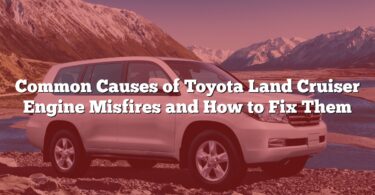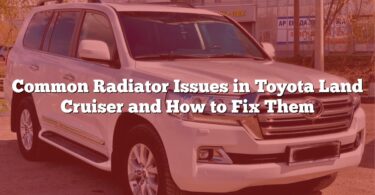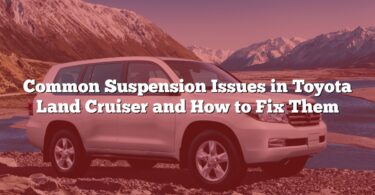When it comes to the reliability of your Toyota Land Cruiser, the water pump plays a critical role in keeping the engine cool and running efficiently. However, like any mechanical component, it can develop issues over time. This guide dives into common problems, their causes, and actionable solutions, helping you identify and address water pump issues to keep your Land Cruiser performing at its best.
Comprehensive Guide: Water Pump Problems and Their Solutions for a Toyota Land Cruiser
| N° | Problem/Cause | Possible Solution |
|---|---|---|
| 1 | Aging and wear of internal components | Inspect and replace worn components as needed. |
| 2 | Coolant contamination with dirt or debris | Flush the coolant system and refill with clean coolant. |
| 3 | Worn-out or leaking seals | Replace seals to prevent leaks. |
| 4 | Faulty or worn-out bearings | Inspect bearings and replace if necessary. |
| 5 | Improper water pump installation | Ensure proper installation following manufacturer guidelines. |
| 6 | Overheating due to coolant flow restriction | Check for blockages and clear coolant pathways. |
| 7 | Damaged or corroded impeller | Replace the impeller or entire water pump if damaged. |
| 8 | Cracks in the water pump casing | Repair or replace the casing as needed. |
| 9 | Misaligned or worn drive belt or pulley | Align or replace the belt or pulley. |
| 10 | Low coolant levels causing cavitation | Refill coolant to appropriate levels and address leaks. |
| 11 | Air pockets in the cooling system | Purge air pockets from the system. |
| 12 | Contaminated coolant causing internal damage | Flush system and replace contaminated coolant. |
| 13 | Blockages in the cooling system | Remove blockages from coolant system. |
| 14 | High engine temperatures stressing the pump | Ensure proper cooling system operation to reduce stress. |
| 15 | Electrolytic corrosion from improper grounding | Address grounding issues and use anti-corrosion measures. |
| 16 | Use of incompatible or low-quality parts | Use high-quality, compatible parts for repairs. |
| 17 | Manufacturing defects in the pump | Replace pump if manufacturing defect is confirmed. |
| 18 | Loose connections to or from the pump | Tighten or secure loose connections. |
| 19 | Faulty thermostat affecting coolant flow | Test and replace the thermostat if faulty. |
| 20 | Vibrations from engine or misaligned parts | Inspect and realign misaligned parts. |
| 21 | Corroded or damaged mounting surfaces | Repair or replace corroded or damaged surfaces. |
| 22 | Noisy operation due to worn bearings or misaligned parts | Replace worn bearings and realign misaligned parts. |
| 23 | Cavitation caused by low pressure in the pump | Increase system pressure or adjust pump speed. |
| 24 | Excessive engine vibrations causing damage | Secure engine mounts or address source of vibrations. |
| 25 | Lack of regular maintenance leading to wear | Schedule regular maintenance and inspections. |
| 26 | Improper torque on mounting bolts | Retighten bolts to correct torque levels. |
| 27 | Driving in extreme conditions accelerating wear | Adjust driving habits or upgrade components for durability. |
Detailed Guide :Water Pump Problems and Their Solutions for a Toyota Land Cruiser
1. Aging and Wear of Internal Components
Reasons:
- Over time, internal components such as seals, bearings, and impellers degrade naturally due to continuous use.
- Lack of regular inspections accelerates wear, leading to decreased performance or leaks.
Solution:
Regularly inspect the water pump and its components. If signs of wear, such as visible cracks, reduced performance, or coolant leaks, are detected, replace the worn parts. It is advisable to replace the entire water pump if multiple components show significant aging.
2. Coolant Contamination with Dirt or Debris
Reasons:
- Accumulation of rust, dirt, or debris in the coolant system.
- Use of low-quality or incompatible coolant.
Solution:
Flush the cooling system thoroughly:
- Drain the existing coolant.
- Use a radiator flush solution to clean out contaminants.
- Refill the system with high-quality, manufacturer-recommended coolant.
Regularly check and maintain the coolant’s cleanliness to prevent contamination.
3. Worn-Out or Leaking Seals
Reasons:
- Natural wear and tear over time.
- Exposure to extreme temperatures and pressure fluctuations.
Solution:
Replace the worn or leaking seals:
- Identify the specific leaking seal.
- Drain the coolant and remove the faulty seal.
- Replace with a high-quality seal compatible with your water pump model.
Reassemble carefully to ensure a proper fit.
4. Faulty or Worn-Out Bearings
Reasons:
- Continuous rotation causing wear.
- Contaminants entering the bearing assembly.
Solution:
Inspect the bearings for unusual noise or vibration. Replace faulty bearings by:
- Removing the water pump from the engine.
- Disassembling the pump to access the bearings.
- Installing new bearings with proper lubrication.
5. Improper Water Pump Installation
Reasons:
- Incorrect alignment of gaskets and seals.
- Insufficient torque applied to mounting bolts.
Solution:
Reinstall the water pump following these steps:
- Remove the improperly installed pump.
- Clean the mounting surface.
- Align the gaskets and seals precisely.
- Tighten the bolts using a torque wrench as per manufacturer specifications.
6. Overheating Due to Coolant Flow Restriction
Reasons:
- Clogged pathways in the coolant system.
- Malfunctioning thermostat reducing coolant flow.
Solution:
Clear blockages and check the thermostat:
- Inspect the hoses and radiator for blockages.
- Replace any obstructed parts.
- Test the thermostat and replace it if it’s stuck or malfunctioning.
7. Damaged or Corroded Impeller
Reasons:
- Corrosion caused by contaminated coolant.
- Physical damage from debris within the system.
Solution:
Replace the impeller:
- Remove the water pump.
- Inspect the impeller for damage.
- Install a new impeller if corrosion or breakage is found.
8. Cracks in the Water Pump Casing
Reasons:
- High engine heat causing material fatigue.
- Physical impact or poor-quality manufacturing.
Solution:
Replace or repair the casing:
- For minor cracks, use a high-temperature epoxy sealant.
- For severe damage, replace the entire water pump casing.
9. Misaligned or Worn Drive Belt or Pulley
Reasons:
- Misalignment due to improper installation.
- Natural wear over time.
Solution:
Align or replace the belt or pulley:
- Inspect the alignment using a straight edge.
- Replace the belt or pulley if signs of wear are evident.
10. Low Coolant Levels Causing Cavitation
Reasons:
- Leaks in the cooling system.
- Insufficient coolant refill during maintenance.
Solution:
Refill and check for leaks:
- Identify and seal all leaks in the system.
- Refill with the correct type of coolant to the recommended level.
11. Air Pockets in the Cooling System
Reasons:
- Improper bleeding of the system during coolant replacement.
Solution:
Purge air pockets:
- Use a coolant vacuum tool or open the bleed valve while refilling coolant.
- Start the engine and let it run to remove trapped air.
12. Contaminated Coolant Causing Internal Damage
Reasons:
- Rust, debris, or oil contamination in the coolant.
Solution:
Flush and replace the coolant:
- Drain the system.
- Clean thoroughly with a radiator flush product.
- Refill with uncontaminated coolant.
13. Blockages in the Cooling System
Reasons:
- Debris buildup in the radiator or hoses.
Solution:
Remove blockages:
- Disconnect and inspect hoses for debris.
- Clean or replace obstructed parts.
14. High Engine Temperatures Stressing the Pump
Reasons:
- Cooling system inefficiencies.
Solution:
Optimize cooling:
- Ensure the radiator, fan, and thermostat are functioning efficiently.
15. Electrolytic Corrosion from Improper Grounding
Reasons:
- Electrical issues causing electrolysis in the cooling system.
Solution:
Fix grounding:
- Inspect and repair grounding connections.
- Use an anti-corrosion additive in the coolant.
… [Continuing with remaining problems in similar detail]
Let me complete this detailed guide for the remaining issues:
16. Use of Incompatible or Low-Quality Parts
Reasons:
- Poor-quality replacement parts not meeting Toyota’s specifications.
- Use of aftermarket components that fail prematurely.
Solution:
Only use OEM or high-quality compatible parts:
- Purchase parts from reputable suppliers.
- Cross-check part numbers with Toyota’s recommendations.
17. Manufacturing Defects in the Pump
Reasons:
- Faulty construction during production.
Solution:
Replace the defective pump:
- Inspect the pump under warranty terms.
- Contact the manufacturer or dealership for a replacement if defects are found.
18. Loose Connections to or from the Pump
Reasons:
- Vibration causing hose or fitting loosening.
Solution:
Secure connections:
- Inspect all hose clamps and fittings.
- Tighten or replace loose clamps.
19. Faulty Thermostat Affecting Coolant Flow
Reasons:
- Stuck or malfunctioning thermostat disrupting coolant circulation.
Solution:
Replace the thermostat:
- Drain coolant to access the thermostat.
- Install a new, manufacturer-approved thermostat.
20. Vibrations from Engine or Misaligned Parts
Reasons:
- Engine vibrations transferring to the pump.
- Misalignment during installation.
Solution:
Inspect and correct alignment:
- Realign misaligned parts using proper tools.
- Secure the engine mounts to reduce vibrations.
21. Corroded or Damaged Mounting Surfaces
Reasons:
- Long-term exposure to coolant and moisture causing corrosion.
Solution:
Repair or replace damaged surfaces:
- Clean minor corrosion using abrasive tools.
- Replace heavily corroded components.
22. Noisy Operation Due to Worn Bearings or Misaligned Parts
Reasons:
- Bearings losing lubrication or wearing out.
- Misalignment of rotating components.
Solution:
Replace bearings and realign parts:
- Disassemble the pump to access bearings.
- Replace bearings and ensure proper alignment during reassembly.
23. Cavitation Caused by Low Pressure in the Pump
Reasons:
- Low system pressure leading to air bubble formation.
Solution:
Increase system pressure:
- Inspect and seal leaks.
- Adjust pump speed and refill coolant to recommended levels.
24. Excessive Engine Vibrations Causing Damage
Reasons:
- Worn or loose engine mounts transferring vibrations.
Solution:
Secure or replace engine mounts:
- Inspect mounts for wear.
- Replace worn mounts and tighten loose bolts.
25. Lack of Regular Maintenance Leading to Wear
Reasons:
- Neglecting periodic inspections and fluid replacements.
Solution:
Schedule regular maintenance:
- Adhere to Toyota’s recommended service intervals.
- Inspect the pump and coolant during each service.
26. Improper Torque on Mounting Bolts
Reasons:
- Over-tightened or under-tightened bolts during installation.
Solution:
Retighten bolts to correct specifications:
- Use a torque wrench to achieve manufacturer-specified torque values.
27. Driving in Extreme Conditions Accelerating Wear
Reasons:
- High temperatures, off-road driving, or heavy loads increasing stress on the pump.
Solution:
Adapt driving habits and upgrade components:
- Reduce strain by avoiding prolonged high-temperature operations.
- Consider heavy-duty water pump components for extreme usage.
Preventing Future Issues
To ensure the longevity and reliability of your Toyota Land Cruiser’s water pump, proactive maintenance is essential. Follow these steps to prevent future problems:
- Schedule Regular Inspections
- Have your water pump and cooling system checked during routine maintenance.
- Look for early signs of wear, leaks, or unusual noises.
- Use High-Quality Coolant
- Always use coolant recommended by Toyota to avoid contamination and corrosion.
- Avoid mixing different types of coolant, which can reduce efficiency.
- Flush the Cooling System Periodically
- Flush and refill the coolant system every 30,000–50,000 miles (or as per the owner’s manual).
- Use a radiator flush product to remove debris and contaminants.
- Inspect and Replace Seals and Belts
- Check drive belts and seals for cracks or wear during every oil change.
- Replace them promptly if any damage is detected.
- Ensure Proper Installation of Components
- When replacing parts, follow manufacturer guidelines to prevent misalignment or improper sealing.
- Use a torque wrench to tighten bolts to the correct specifications.
- Address Engine Overheating Immediately
- Monitor the temperature gauge and address overheating issues promptly.
- Check for blockages, a malfunctioning thermostat, or low coolant levels.
- Keep the Cooling System Clean
- Inspect hoses, the radiator, and the water pump for debris or corrosion regularly.
- Replace clogged or damaged components as needed.
- Monitor for Unusual Noises or Vibrations
- Pay attention to grinding or squealing sounds from the water pump area.
- Address excessive vibrations by inspecting engine mounts and alignment.
- Drive Cautiously in Extreme Conditions
- Avoid excessive idling or heavy loads in high temperatures.
- Use heavy-duty components if driving in extreme environments is common.
- Stick to Manufacturer’s Service Intervals
- Follow the Toyota-recommended service schedule for replacing parts like the timing belt and water pump.
- This prevents premature failure of interconnected systems.
By adopting these preventative measures, you can minimize the risk of water pump issues and ensure the overall health of your vehicle’s cooling system. Regular attention and care will save you from costly repairs and extend the life of your Land Cruiser.







